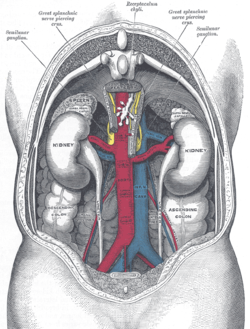Gonadal vein
| Gonadal vein | |
|---|---|
 The relations of the viscera and large vessels of the abdomen (as seen from behind). | |
| Details | |
| Drains from | Ovary, Testicle |
| Source | Renal vein, Inferior vena cava |
| Artery | gonadal artery |
| Anatomical terminology | |
In medicine, gonadal vein refers to the blood vessel that carries blood away from the gonad (testis, ovary) toward the heart. These are different arteries in women (ovarian vein) and men (testicular vein), but share the same embryological origin.[1]
The termination of the two gonadal veins in an individual is usually asymmetrical, with the left one draining into the left renal vein, and the right one draining into the inferior vena cava.
Structure
Fate
The left gonadal vein usually empties into (inferior aspect of)
The right gonadal vein typically empties directly into the (right anterolateral aspect of) inferior vena cava, joining it at an acute angle, some 2 cm inferior to the ipsilateral renal vein. Occasionally (in about 6% of individuals[2]), it empties into the ipsilateral renal vein[3]: 1144 like its contralateral fellow.[2]
Variation
In the lower abdomen, there may be multiple vessels instead of a single gonadal vein. Sometimes, these vessels do not converge into a single unified gonadal vein superiorly, instead terminating as two separate vessels on either side.[3]: 1144
Clinical significance
Prolonged venous insufficiency of gonadal veins may lead to an increase in lower limb varicose vein formation in both sexes.[4]
References
- ISBN 978-0-323-67969-5, retrieved 2021-02-04
- ^ PMID 30855882, retrieved 2022-08-04
- ^ OCLC 1201341621.)
{{cite book}}: CS1 maint: location missing publisher (link) CS1 maint: others (link - S2CID 206505480.
